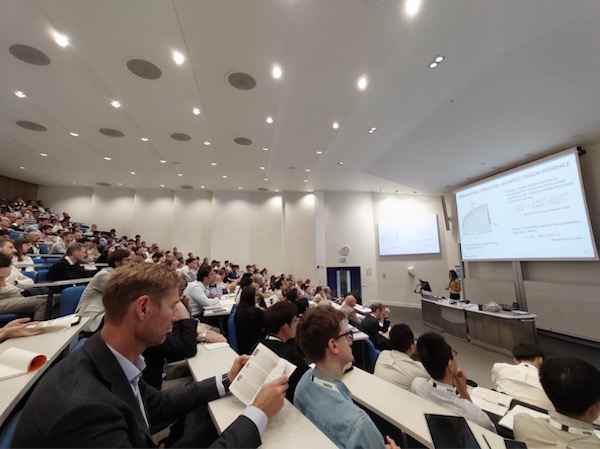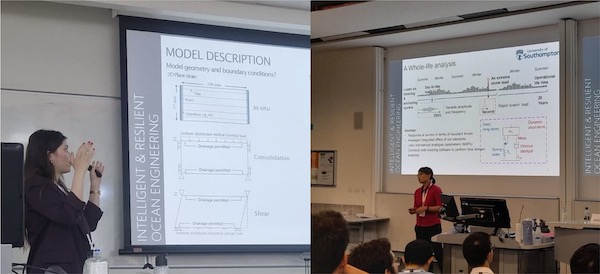IROE team profile ocean engineering research at 10th International Conference on Numerical Methods in Geotechnical Engineering

Researchers from the Centre of Excellence for Intelligent & Resilient Ocean Engineering took part in the recent 10th International Conference on Numerical Methods in Geotechnical Engineering, held 26 - 28 June 2023 in London, UK.
This series of conferences, organised by the ERTC7 (European Regional Technical Committee 7 for Numerical Methods) under the auspices of the International Society for Soil Mechanics and Geotechnical Engineering (ISSMGE), started in 1986 (Stuttgart, Germany), followed by conferences every four years: Santander, Spain, in 1990, Manchester, United Kingdom, in 1994, Udine, Italy, in 1998, Paris, France, in 2002, Graz, Austria, in 2006, Trondheim, Norway, in 2010, Delft, The Netherlands, in 2014 and Porto, Portugal, in 2018. NUMGE 2023 provided a forum for academics, researchers and engineering practitioners to meet and discuss the current state-of-the-art in numerical methods in Geotechnical Engineering and highlight current challenges faced in their application to geotechnical problems.

Professor Susan Gourvenec, RAEng Chair in Emerging Technologies for Intelligent & Resilient Ocean Engineering delivered the opening keynote to the conference “Numerical modelling in geotechnical design of offshore infrastructure – Evolution and Revolution”. Numerical modelling has played a significant role in offshore geotechnical design since the emergence of the offshore energy sector and will play a significant role in solving the geotechnical engineering challenges of delivering the energy transition. In this keynote paper, Susan highlighted some of the roles of numerical modelling in geotechnical design of offshore infrastructure. In particular, the role of numerical modelling in development of (i) the failure envelope method to capture effects of multi-directional loading, and (ii) critical state-based macro models to capture through-life softening and hardening of seabeds around offshore infrastructure to enable uptake of whole-life geotechnical design. Susan noted the irony that the design methods highlighted avoid the geotechnical engineer/end user having to do (so much) numerical modelling! However, reiterated, as was shown with numerous examples, through the paper and presentation that the development and acceptance of both methods have relied heavily on numerical modelling, and in particular finite element analysis, to underpin the simplified design tools. The paper provided insight into the significant role of numerical modelling in offshore geotechnical design, and the potential for numerical analysis to address the key offshore geotechnical design imperatives that are essential for the sector to meet the offshore wind ambitions globally to contribute to a lower carbon future.
IROE PhD student Noor Laham presented the paper “Finite Element Modelling of Direct Simple Shear (DSS) Tests with Pre-Failure Episodic Shearing and Consolidation” that she co-authored with PhD supervisors Dr Katherine Kwa, and Professors Gourvenec and White from University of Southampton, and industry sponsor and supervisor Dr Yusuke Suzuki from the Norwegian Geotechnical Institute. The paper presents a finite element model simulating DSS tests of a normally consolidated clay under (i) displacement-controlled undrained monotonic shear to failure and (ii) load-controlled undrained episodic monotonic pre-failure shear with intervening consolidation. Two critical state constitutive models were considered, Modified Cam Clay (MCC) and Clay Hypoplasticity, and the numerical results were compared with experimental DSS test results to assess the realism of the numerical model. It is demonstrated that the MCC model can capture the stress–strain–volume response of undrained monotonic shear to failure, and a single episode of pre-failure shear and subsequent consolidation, while the Clay Hypoplasticity model can also capture the softening and hardening response in subsequent episodes of pre-failure shear and consolidation, as a result of the inclusion of pre-yield pore pressure generation. The finite element model enables interrogation of aspects of soil response that are not available from the experimental element test output, and enables exploration of an extensive sweep of parameter combinations that would be impractical in the laboratory.

Dr Katherine Kwa presented “Integrated numerical modelling of soil-anchor-mooring line-floater response for floating offshore wind” co-authored with IROE PhD student Oscar Festa and Professors White, Sobey and Gourvenec. The paper presented the development of an anchor macro model and its integration with mooring analyses, for easy coupling of the anchor-seabed-mooring response and full system modelling of a floating offshore wind turbine. The model combines techniques that (i) mobilise additional seabed resistance by considering the added mass and whole-life effects of changing strength of the seabed and (ii) reduce the anchor loads by considering a compliant mooring system, to result in reduced required anchor size. The benefits of combining these approaches are shown to lead to reductions of up to 50 % in the minimum required anchor size for the same system reliability.

Dr Benjamin Cerfontaine presented “DEM modelling of screw piles as foundations for floating offshore wind turbines”. Screw piles are efficient foundations for offshore renewable energy devices. Guidance recommends that they are installed in a perfect (pitch-matched) manner, in order to limit the soil disturbance. However, this necessitates the application of a vertical compressive (or crowd) force at their head, whose magnitude for upscaled offshore foundations is impractical or costly to impose in the field. Experimental testing had shown that screw pile over-flighting during installation in sand, i.e. applying more rotations than recommended for a given downwards displacement, has the potential to reduce the vertical load without degrading the foundation resistance. Discrete element modelling (DEM) simulations were undertaken to explore this seemingly counter-intuitive outcome. Different boundary conditions (constant stiffness radial rings, fixed walls or constant pressure) were tested. The DEM simulations were shown to capture well the experimental results when a constant stiffness was applied and were able to identify the origin of the torque and penetration resistance during installation.
Papers from the IROE team are hyperlinked above and are available open access from the links.
All papers from the conference will be made available open access via https://www.issmge.org/publications